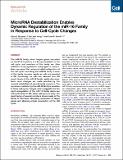MicroRNA Destabilization Enables Dynamic Regulation of the miR-16 Family in Response to Cell-Cycle Changes
Author(s)
Rissland, Olivia S.; Hong, Sue-Jean; Bartel, David; Rissland, Olivia S.
DownloadBartel_MicroRNA.pdf (1.779Mb)
PUBLISHER_POLICY
Publisher Policy
Article is made available in accordance with the publisher's policy and may be subject to US copyright law. Please refer to the publisher's site for terms of use.
Terms of use
Metadata
Show full item recordAbstract
The miR-16 family, which targets genes important for the G1-S transition, is a known modulator of the cell cycle, and members of this family are often deleted or downregulated in many types of cancers. Here, we report the reciprocal relationship—that of the cell cycle controlling the miR-16 family. Levels of this family increase rapidly as cells are arrested in G0. Conversely, as cells are released from G0 arrest, levels of the miR-16 family rapidly decrease. Such rapid changes are made possible by the unusual instabilities of several family members. The repression mediated by the miR-16 family is sensitive to these cell-cycle changes, which suggests that the rapid upregulation of the miR-16 family reinforces cell-cycle arrest in G0. Upon cell-cycle re-entry, the rapid decay of several members allows levels of the family to decrease, alleviating repression of target genes and allowing proper resumption of the cell cycle.
Date issued
2011-09Department
Massachusetts Institute of Technology. Department of Biology; Whitehead Institute for Biomedical ResearchJournal
Molecular Cell
Publisher
Elsevier B.V.
Citation
Rissland, Olivia S., Sue-Jean Hong, and David P. Bartel. “MicroRNA Destabilization Enables Dynamic Regulation of the miR-16 Family in Response to Cell-Cycle Changes.” Molecular Cell 43, no. 6 (September 2011): 993-1004.© 2011 Elsevier Inc.
Version: Final published version
ISSN
10972765
1097-4172